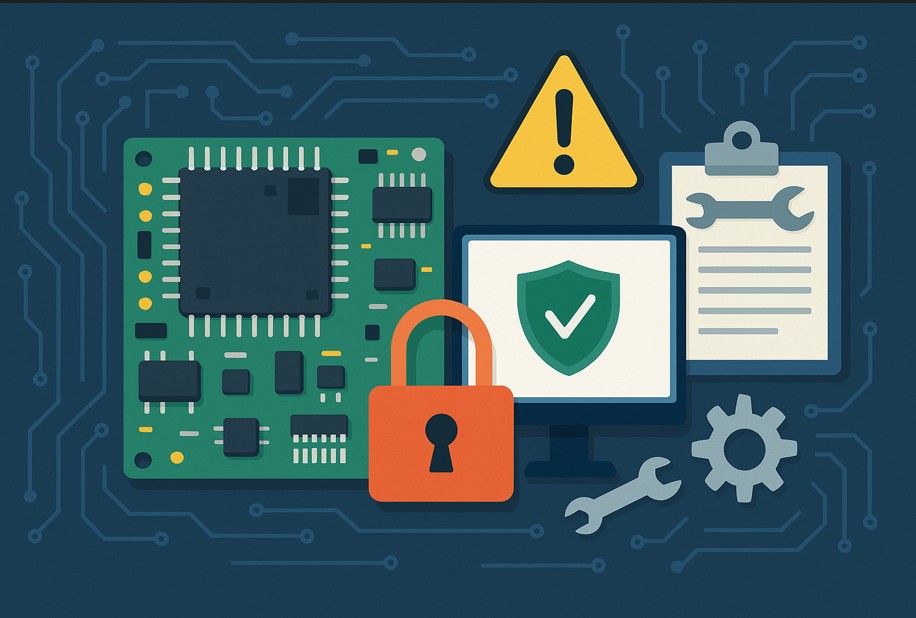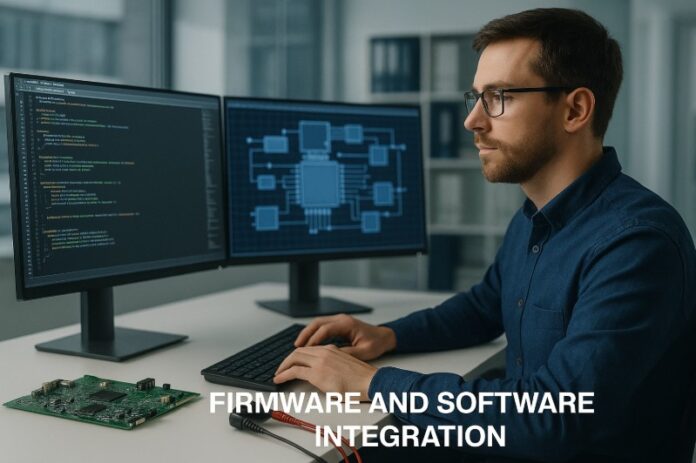The landscape of software, firmware and application development for embedded systems has evolved dramatically in the last decade. From IoT wearables and industrial controllers to automotive ECUs and medical devices, embedded systems are the backbone of modern technology. Every smart device that interacts with sensors, communicates wirelessly, or processes data locally depends on a harmonious integration of hardware, firmware, and software. The foundation often begins with precise pcb design, which provides the hardware platform upon which firmware and application logic operate. Building an efficient, reliable, and secure embedded system requires expertise across hardware interfaces, low-level firmware, real-time operating systems (RTOS), communication protocols, and user-facing applications.
Embedded Firmware Development Services
Firmware development is at the core of any embedded system. It serves as the critical bridge between hardware and software, controlling peripherals, executing logic, and communicating with higher-level systems or cloud environments. Embedded firmware development services include writing, optimizing, and validating the code that drives microcontrollers, processors, and SoCs. The process typically involves configuring hardware abstraction layers (HAL), writing drivers for sensors or actuators, implementing communication protocols (UART, SPI, I2C, CAN, USB, Ethernet, BLE), and managing power or memory efficiency.
High-quality firmware requires an in-depth understanding of real-time constraints, interrupt handling, bootloader design, and error recovery. Firmware engineers must often balance performance, energy efficiency, and reliability. For mission-critical applications — such as medical or automotive — the firmware must meet certification standards like ISO 26262 or IEC 62304. These services often include continuous integration pipelines, automated unit testing, static analysis, and hardware-in-the-loop (HIL) simulations to validate firmware reliability before deployment.
Custom Software for Embedded
While firmware directly manages hardware, embedded software often operates at a higher abstraction layer, performing data management, control algorithms, and communication with external systems or networks. Custom software for embedded devices can be tailored to the unique functionality of a product — from data acquisition systems to network gateways.
For example, an industrial IoT gateway might run Linux or a real-time OS and execute custom software that aggregates sensor data, applies filtering or AI-based predictive analytics, and transmits results to the cloud through MQTT or HTTP protocols. Custom embedded software development involves designing modular architectures that are portable, maintainable, and secure. It also integrates with cloud APIs, user interfaces, and mobile apps, allowing users to interact with devices remotely.
Selecting the right language and operating environment is key — C and C++ dominate bare-metal and RTOS-based systems, while Python, C#, or Java may be used in more resource-rich environments. The growing use of embedded Linux (Yocto, Buildroot, Ubuntu Core) enables faster feature updates and remote management capabilities.
App Development for Devices
As embedded systems become more connected, app development has become a vital extension of the product ecosystem. Applications allow users to control, monitor, and configure devices in real-time from smartphones or PCs. App development for devices bridges the gap between the physical embedded hardware and the user interface.
Such applications can include:
- Mobile apps to monitor sensors or devices through Bluetooth or Wi-Fi
- Desktop configuration tools for firmware upgrades or calibration
- Web dashboards for remote monitoring and analytics
For example, a home automation system might include a mobile app that connects via BLE or Wi-Fi to control lighting, HVAC, or security systems. These apps must be lightweight, intuitive, and reliable, often incorporating features like over-the-air (OTA) firmware updates, device pairing, or diagnostics. Developers frequently use cross-platform frameworks like Flutter, React Native, or Xamarin to reduce time to market and support both iOS and Android platforms.
Embedded Systems Programming
Embedded systems programming involves writing code that interacts directly with hardware components. Developers must work close to the hardware, often in constrained environments with limited memory, processing power, or storage. Unlike general-purpose applications, embedded code must operate deterministically and continuously, sometimes without human intervention for years.
Key skills in embedded programming include understanding microcontroller architecture, managing interrupts, working with real-time constraints, and optimizing memory usage. Programming languages such as C, C++, and assembly remain dominant due to their efficiency and control over low-level operations. However, modern embedded environments also support higher-level languages in specific cases, such as Python on microcontrollers (MicroPython) or embedded Java in consumer devices.
Debugging and validation are critical parts of the development process. Developers use tools such as JTAG, SWD, logic analyzers, and oscilloscopes to verify signal timing and code execution. Continuous integration pipelines, automated testing, and simulation environments further improve reliability.
Mobile Apps for Hardware Products
With the expansion of IoT and smart devices, mobile applications are now integral to hardware products. These apps not only improve user experience but also enable real-time data visualization and remote control. Mobile apps for hardware products must integrate seamlessly with embedded firmware using protocols like BLE, Wi-Fi, or NFC.
For example, a wearable fitness tracker sends sensor data to a smartphone app that interprets heart rate, steps, or calories burned. The app may also allow firmware updates via OTA. Similarly, industrial control apps can visualize data from field devices and push configuration changes.
Key considerations include security (encryption, authentication), usability, and performance. Cross-platform frameworks make it feasible to deploy mobile solutions faster across devices, ensuring consistency in functionality and appearance. The integration of cloud services further expands these apps into data analytics, remote monitoring, and predictive maintenance.
Firmware and Software Integration
One of the most challenging and essential aspects of embedded development is firmware and software integration. Successful integration means seamless communication between the low-level firmware and the higher-level software or application layer. This coordination ensures that hardware signals, data packets, and user commands translate correctly across the entire system.
Common integration layers include communication stacks, middleware, and APIs. Developers must handle synchronization between tasks, error handling, and message queues, especially in multi-threaded or real-time environments. Testing tools such as emulators, debuggers, and protocol analyzers are used to confirm data integrity and timing accuracy.
Integration also extends to version management and update mechanisms. Over-the-air (OTA) updates, secure bootloaders, and rollback protection are now standard practices. The ultimate goal is to achieve a cohesive system where hardware, firmware, and software function as a single, reliable unit.
IoT Application Development
IoT application development combines embedded engineering, connectivity, and cloud services into one ecosystem. IoT devices rely on embedded firmware to collect and transmit data, while backend software and mobile apps visualize and manage that data.
Developers focus on scalability, security, and interoperability. IoT systems often include gateways, edge devices, and cloud applications that work together through MQTT, CoAP, or HTTPS protocols. Embedded engineers design energy-efficient communication stacks, while cloud developers handle API integration, data analytics, and visualization.
Security is paramount in IoT design — encryption, authentication, and secure firmware updates are critical. Scalable architectures allow thousands of devices to communicate simultaneously without data loss. In medical or industrial IoT applications, real-time monitoring and predictive maintenance capabilities can save costs and improve safety.
IoT development also emphasizes interoperability through standards such as Matter, Zigbee, or LoRaWAN, allowing devices from different vendors to communicate seamlessly.
Embedded Software Consulting
Developing embedded software requires multidisciplinary expertise, and many companies turn to embedded software consulting services to streamline development. Consultants help define hardware-software architecture, select the right microcontroller or SoC, create development workflows, and optimize product performance.
Consulting firms often assist in:
- RTOS and middleware selection
- System partitioning between hardware and software
- Security and safety compliance (IEC 62304, ISO 26262)
- Performance tuning and code optimization
- Technology migration and hardware upgrades
Embedded consultants also provide audits, training, and validation to ensure the system meets both functional and regulatory requirements. They play a critical role in accelerating product development, reducing technical debt, and improving overall reliability.
Cross-Platform App Development
The demand for device control across multiple operating systems has made cross-platform app development essential. Building one codebase that runs on iOS, Android, and desktop environments reduces cost and time to market.
Tools such as Flutter, React Native, and Qt allow developers to create consistent user interfaces and integrate with embedded devices through BLE, USB, or Wi-Fi APIs. For embedded systems, these apps often provide configuration tools, firmware updates, or monitoring dashboards.
Cross-platform development simplifies maintenance, as updates can be rolled out simultaneously across platforms. It also ensures consistent branding and user experience, which are vital in consumer and industrial markets alike.
Custom Firmware Engineers
At the heart of every successful embedded system are custom firmware engineers — specialists who understand both hardware and software layers. They write efficient code that interfaces directly with microcontrollers, manages timing-sensitive operations, and supports communication protocols.
Firmware engineers handle tasks such as bootloader design, device drivers, sensor integration, power management, and real-time data acquisition. They collaborate closely with hardware teams during PCB design reviews and prototype validation, ensuring firmware aligns with hardware specifications.
A skilled firmware engineer not only programs but also performs testing, debugging, and optimization. They use oscilloscopes, logic analyzers, and emulators to monitor performance, detect anomalies, and verify signal timing. In modern development environments, firmware engineers also work with DevOps pipelines, version control (Git), and continuous integration tools.

Security and Maintenance in Embedded Development
In connected embedded systems, cybersecurity and long-term maintenance are essential. Secure coding practices, firmware signing, encrypted communication, and update management protect devices from attacks. Developers must implement secure bootloaders and OTA mechanisms to allow field updates without compromising safety.
Maintenance includes bug fixes, feature updates, and compatibility adjustments as hardware or cloud infrastructure evolves. Long product lifecycles — often 10+ years in industrial or medical markets — require future-proof firmware and modular software architectures.
Regular audits and penetration testing help identify vulnerabilities before deployment. Using hardware-based security elements (TPMs, secure elements) adds additional protection for sensitive data and firmware integrity.
Integration with PCB Design and Hardware Development
The foundation of any embedded system begins at the hardware level, with detailed pcb design that defines electrical performance, signal integrity, and interface placement. Successful software and firmware teams collaborate with hardware designers early in the process to align pinouts, power domains, and sensor selection.
Design-for-Test (DFT) and Design-for-Manufacture (DFM) principles help minimize production issues and simplify debugging. Embedded developers rely on test points, accessible interfaces, and hardware documentation to build efficient, reliable firmware.
This integration between hardware and software is what transforms a concept into a working product — a key principle for any successful embedded system.
Future Trends in Embedded Development
The embedded landscape continues to evolve rapidly. Key trends shaping the next generation include:
- Integration of AI/ML at the edge for faster decision-making
- Wider adoption of RISC-V architectures
- Real-time Linux and microkernel operating systems
- Modular IoT ecosystems supporting multiple connectivity standards
- Cloud-native DevOps practices extending to embedded pipelines
- Unified codebases for firmware, cloud, and app interfaces
These innovations will allow faster time to market, better scalability, and more intelligent embedded systems that adapt dynamically to user needs.
Conclusion
Software, firmware and application development for embedded systems is a multidisciplinary art that combines hardware expertise, code optimization, user experience, and connectivity. From embedded firmware development services to mobile apps for connected devices, success depends on tight collaboration between engineers, designers, and system architects.
Whether you’re building a medical sensor, automotive ECU, industrial controller, or IoT wearable, each layer — hardware, firmware, and software — must be synchronized. By integrating strong PCB design, efficient firmware, secure communication, and responsive applications, companies can deliver reliable, intelligent, and future-ready embedded products.
